Vegetable and flower production in the central highlands of Vietnam: Current status and perspective strategies
Despite significant contributions of vegetable and flower production
to the improvement of the livelihoods of household producers in the
Central Highlands of Vietnam, several challenges facing the
development of this sector require a general evaluation. This study
aimed at assessing the current situation and economic efficiency of
flowers and vegetables and analyzing the application of production
techniques on the cultivation of these crops. Based on secondary data
sources combined with a primary survey of 144 vegetable farmers
and 74 flower growers in all five provinces (Lam Dong, Dak Lak,
Dak Nong, Kon Tum, and Gia Lai) of the area in 2018, descriptive
statistics and economic values were applied to provide an overview
of the development of vegetable and flower production of the region.
Findings showed that there were large differences in yields and
economic efficiencies of vegetables and flowers among the five
provinces of the Central Highlands. Accordingly, the yields and
economic efficiencies of vegetables and flowers in Lam Dong were
two to five times higher than those in other provinces (Dak Lak, Dak
Nong, Kon Tum, and Gia Lai). In addition, the applications of
technological advances in vegetable and flower production remained
limited. Major challenges for flower and vegetable development
included the lack of irrigation water, weak capabilities of building
flower and vegetable brands, and limitations in market access.
Solutions to improve production technology implications, develop
brands of high-quality products, and raise the ability to access market
for all vegetable and flower stakeholders are highly recommended
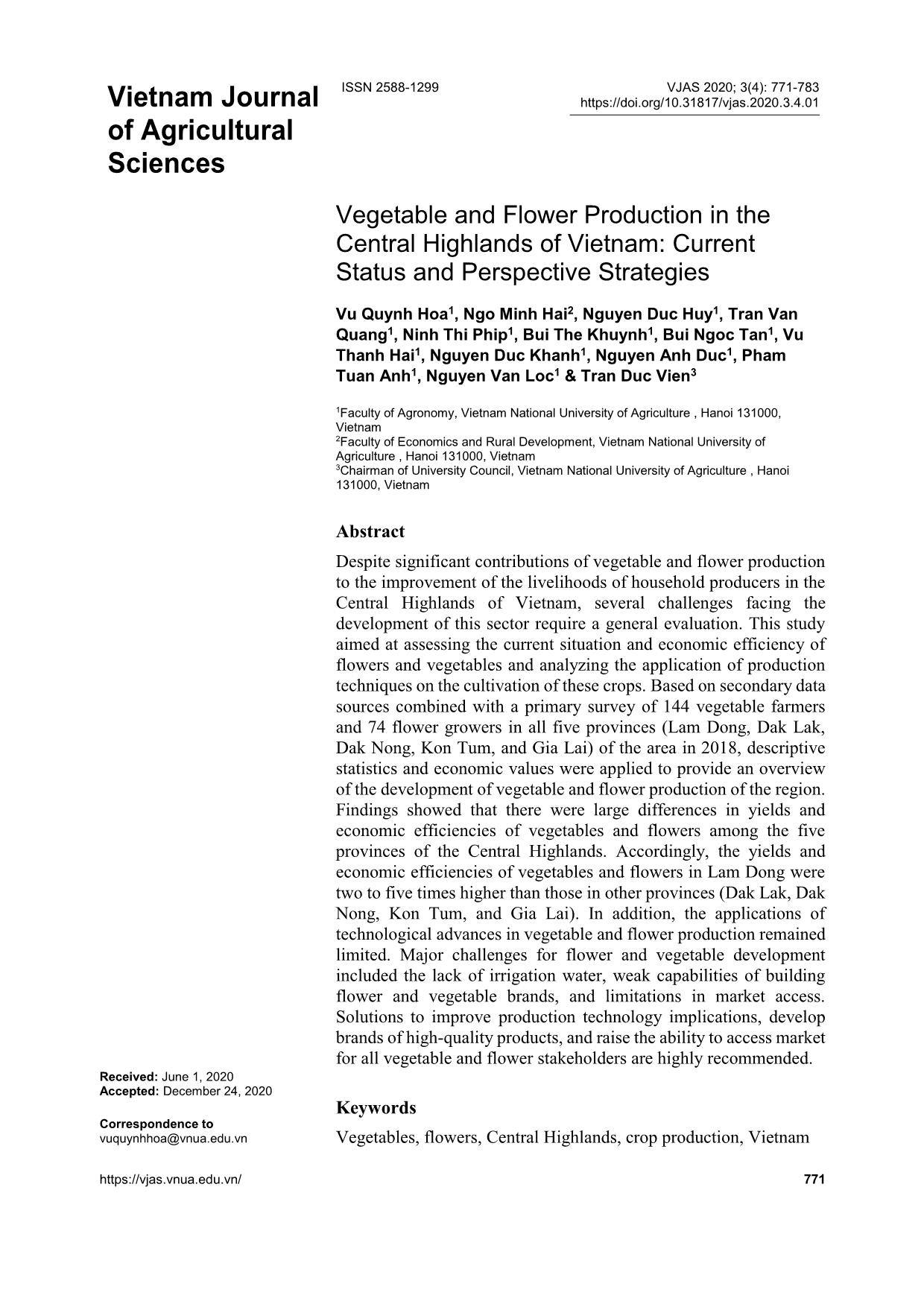
Trang 1
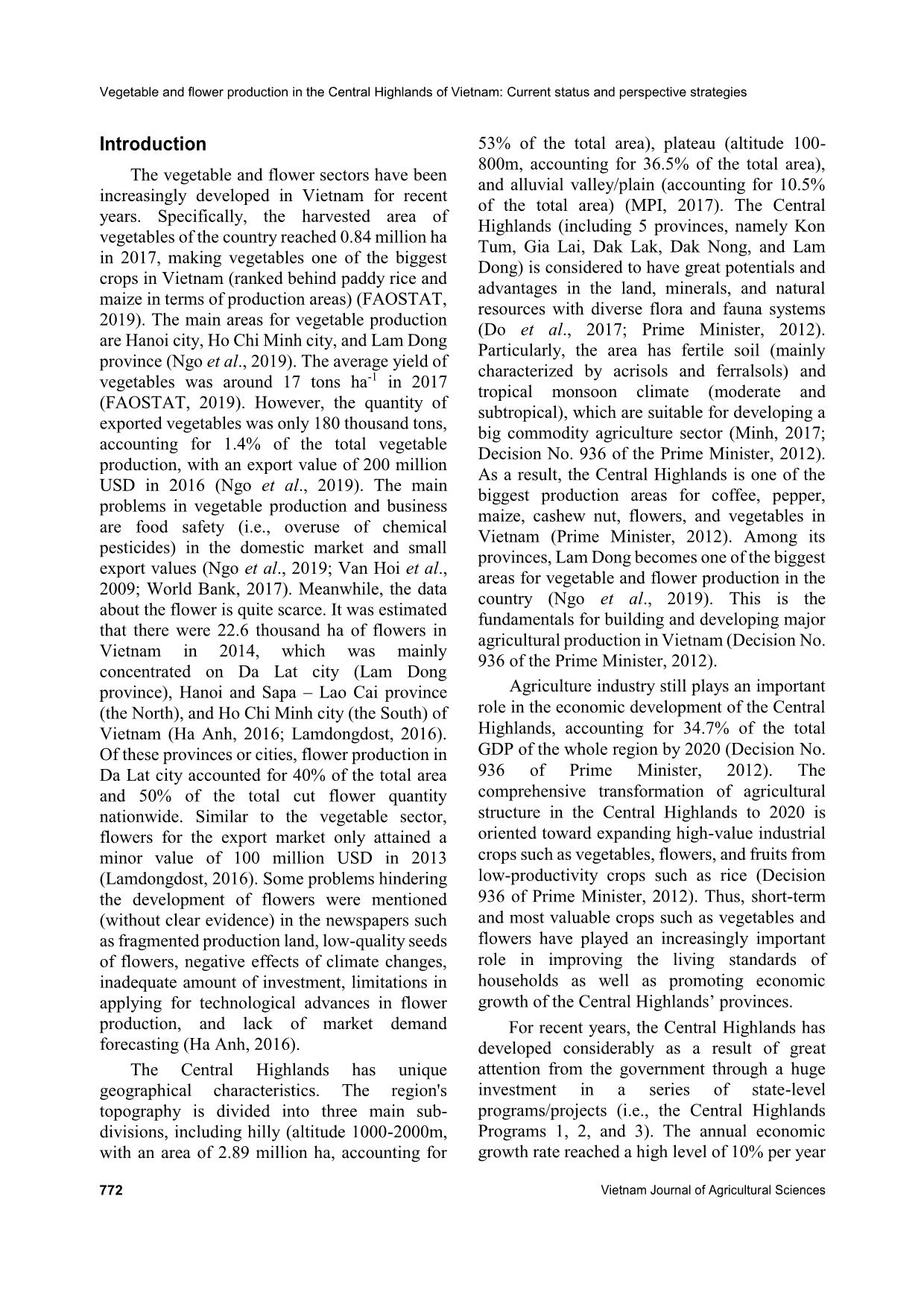
Trang 2
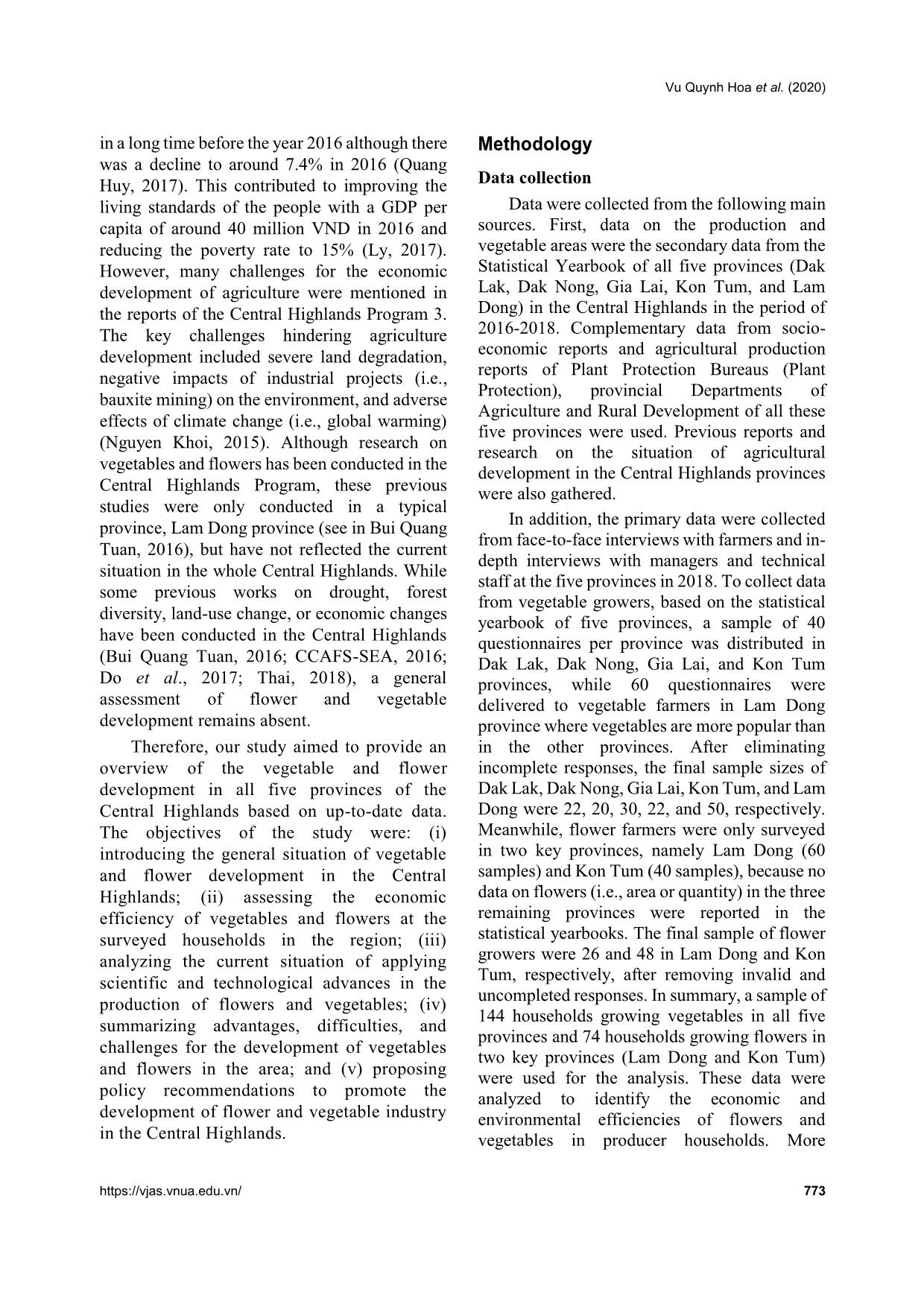
Trang 3
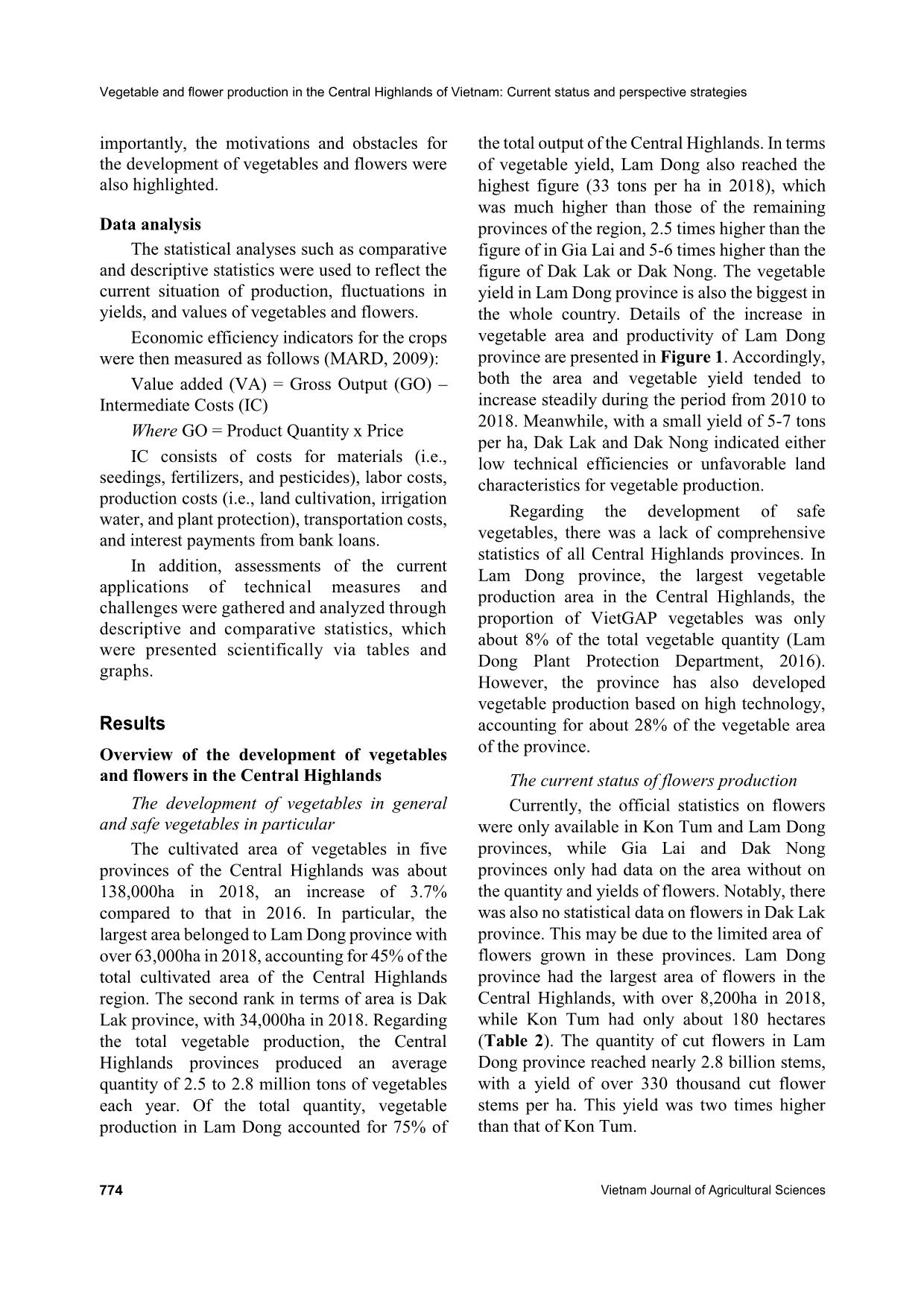
Trang 4
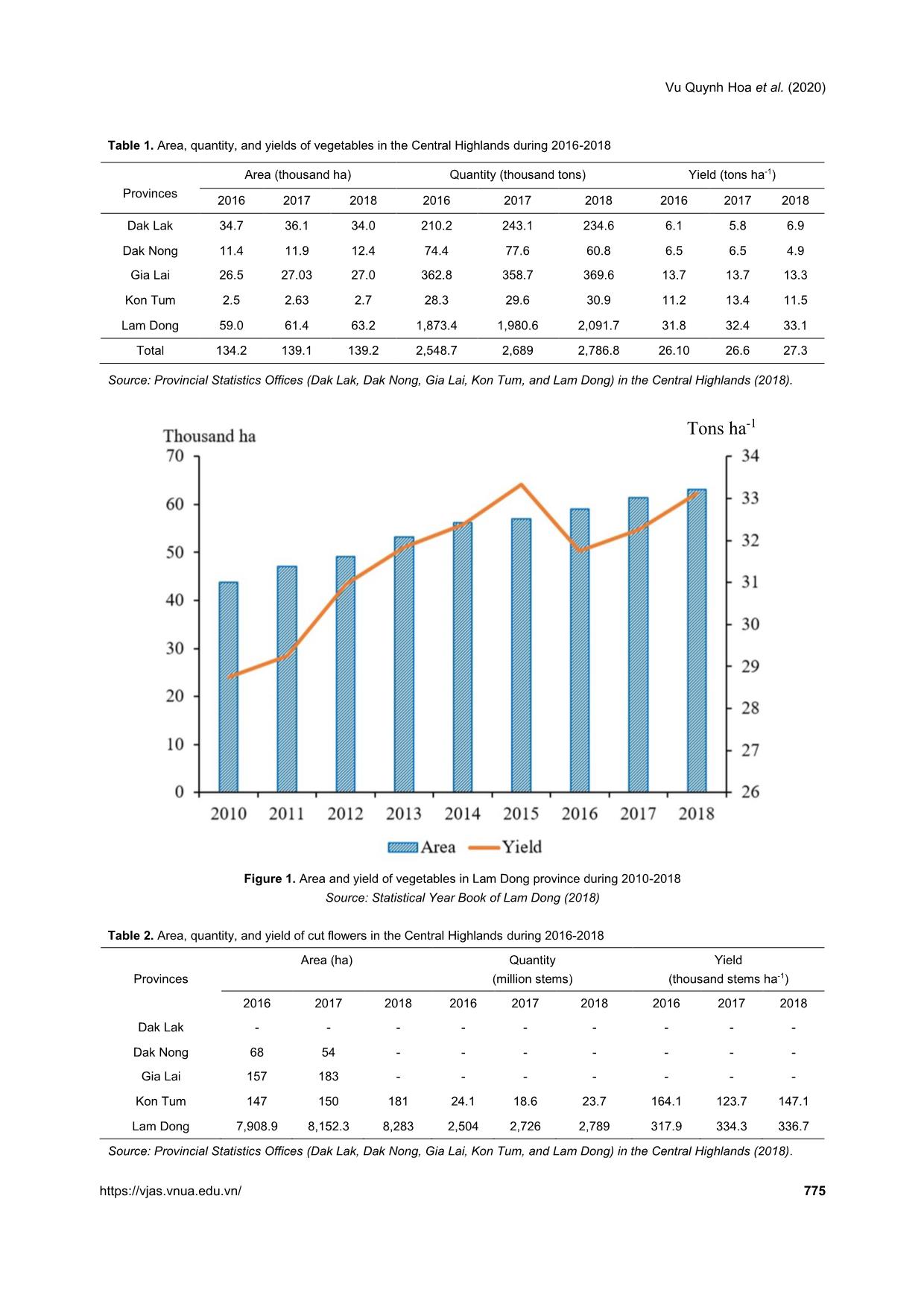
Trang 5
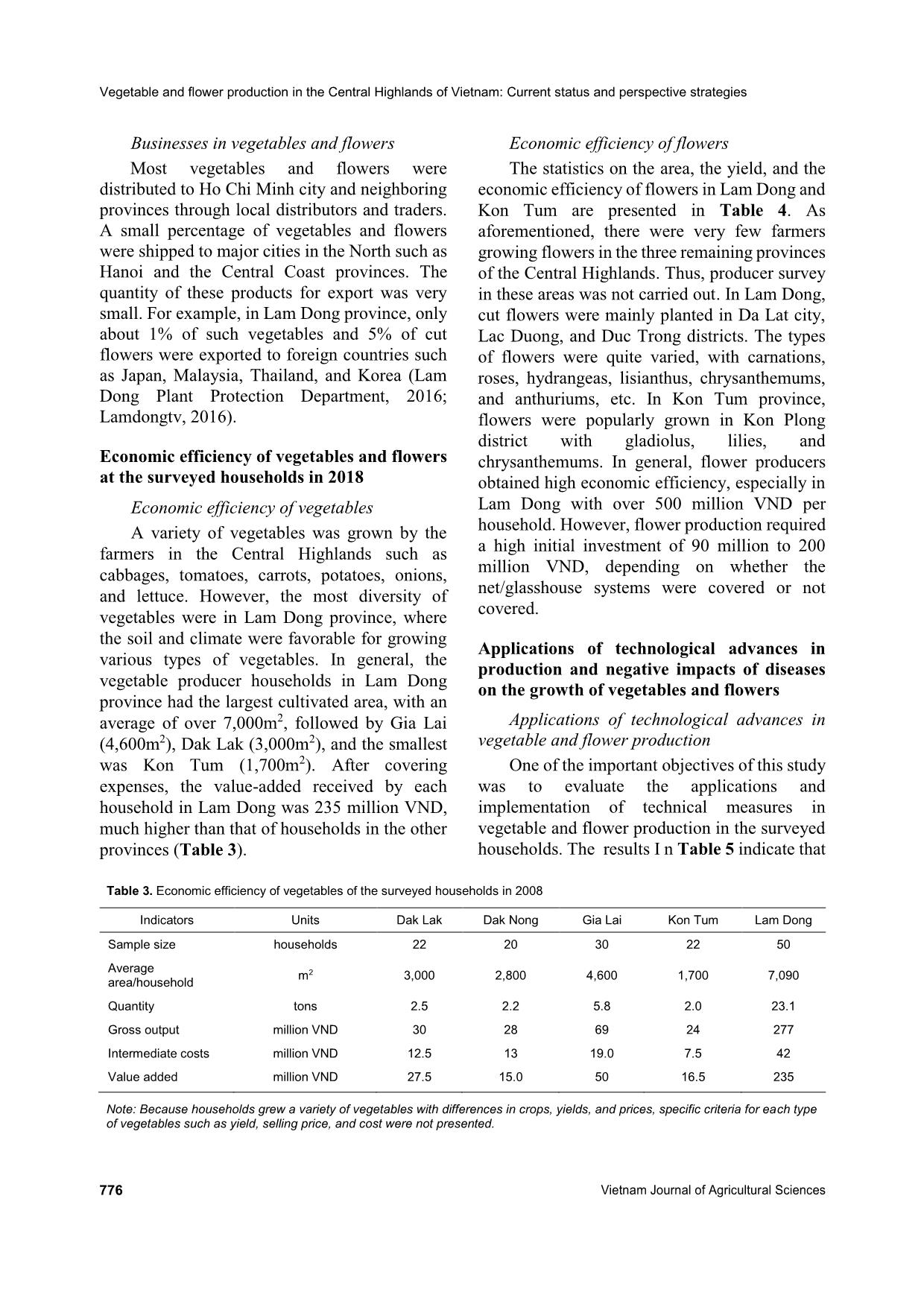
Trang 6
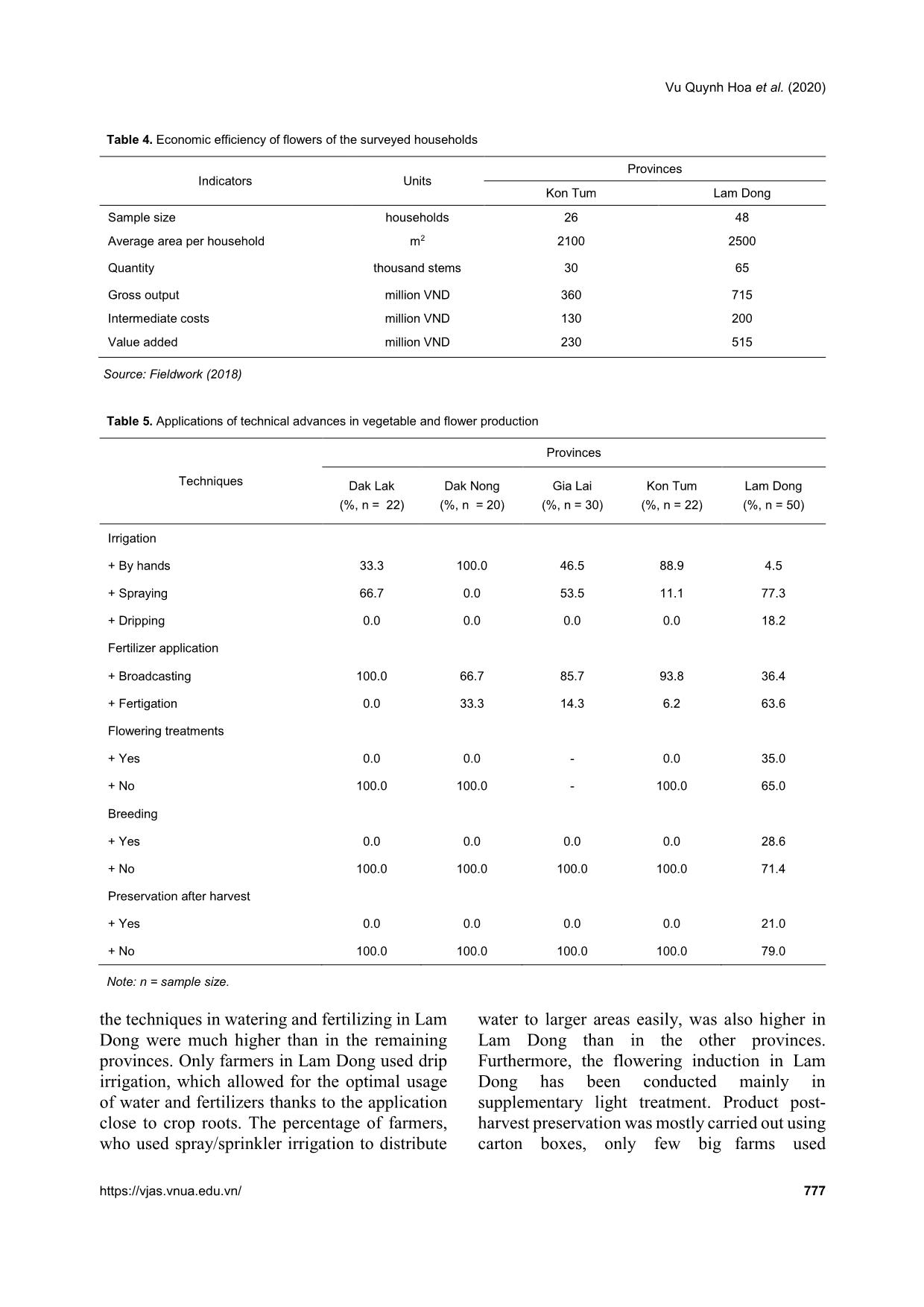
Trang 7
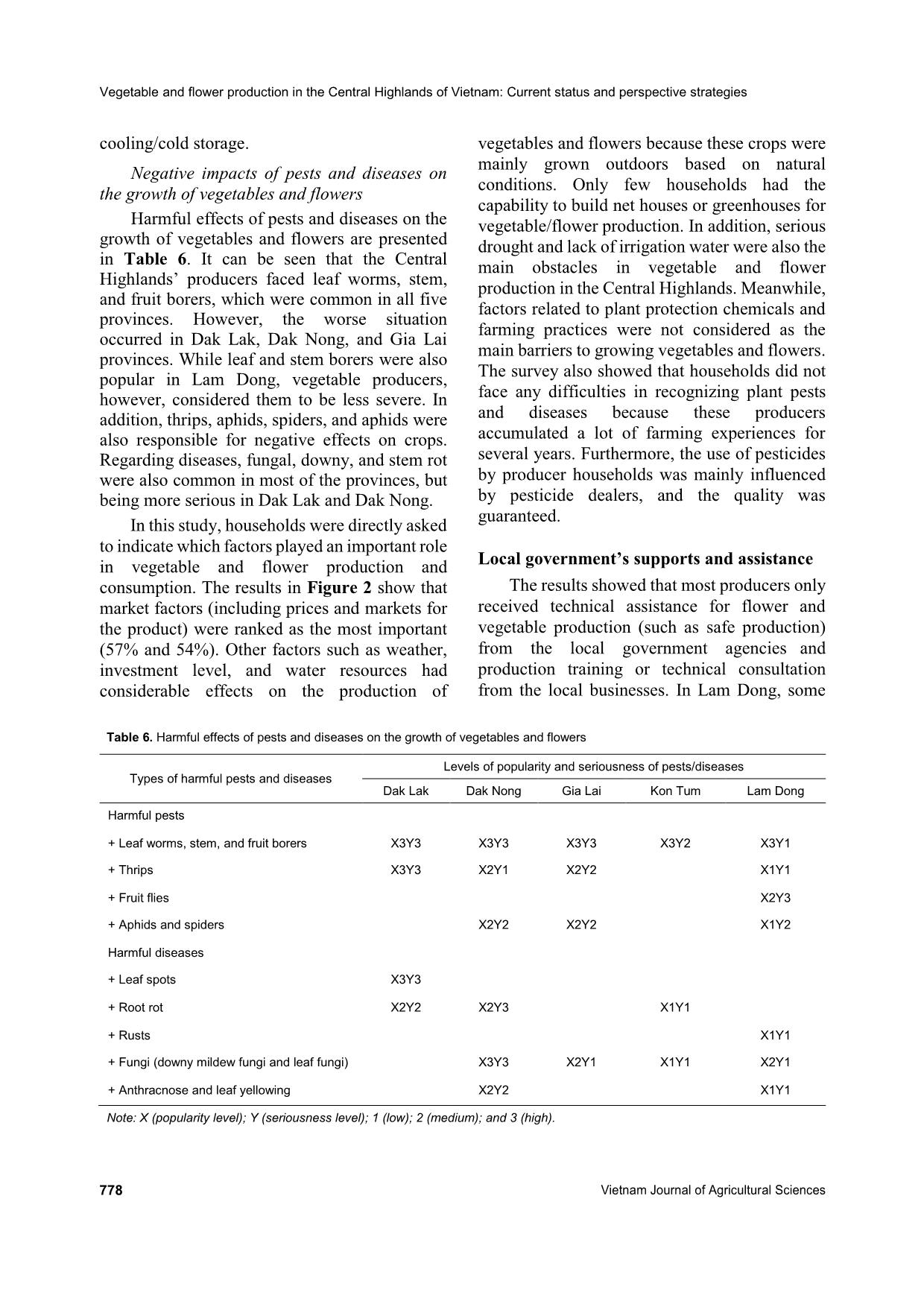
Trang 8
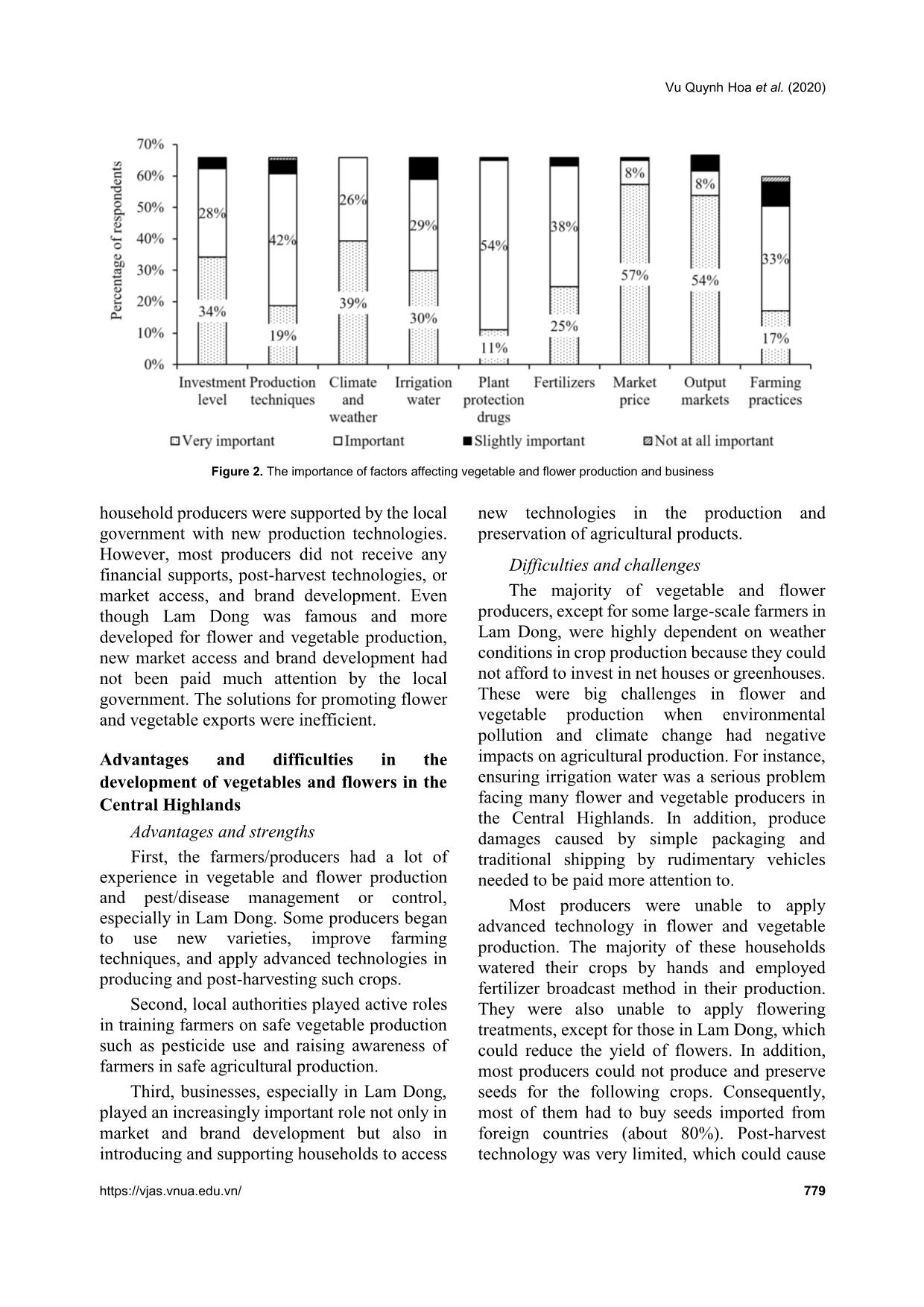
Trang 9
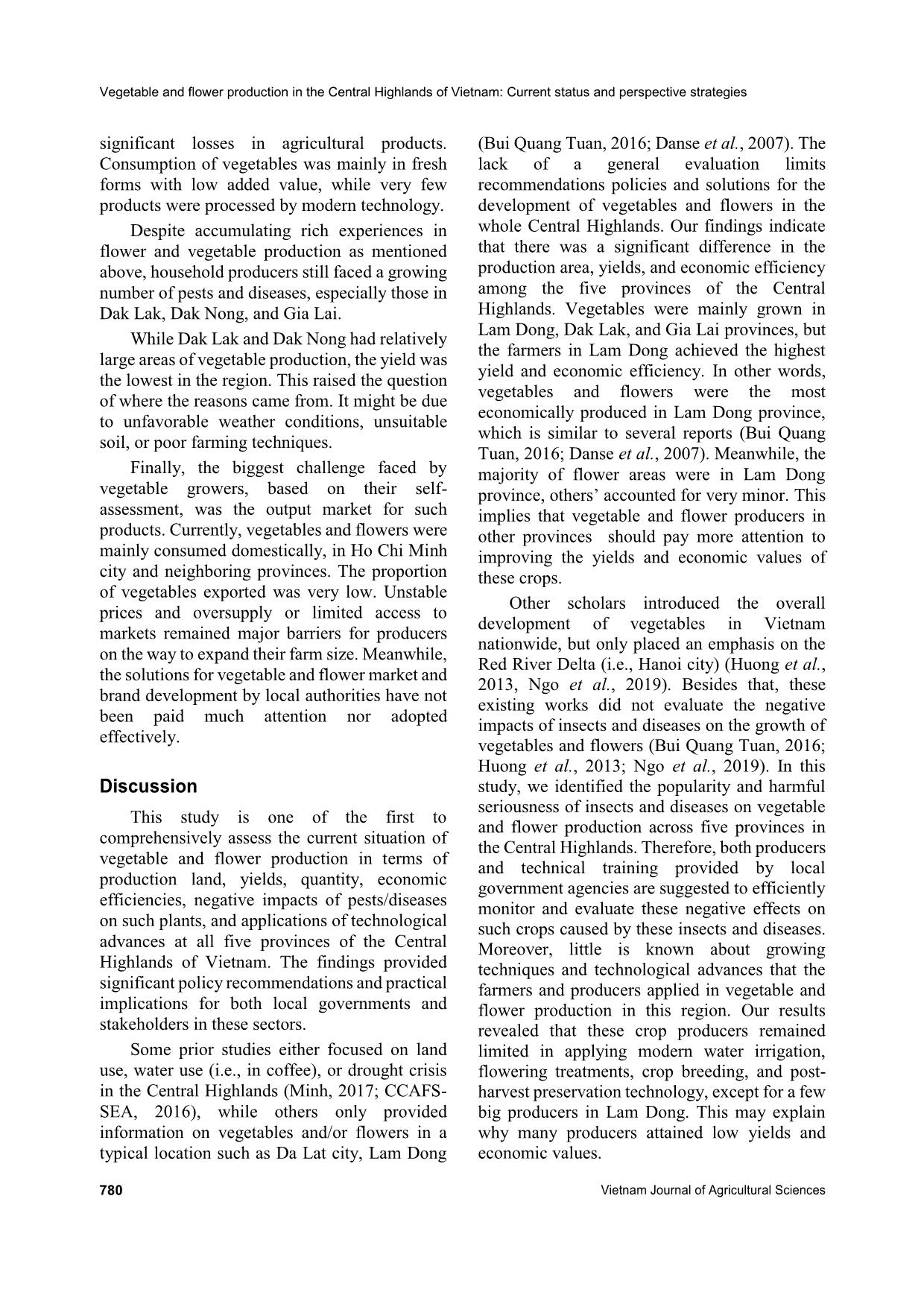
Trang 10
Tải về để xem bản đầy đủ
Tóm tắt nội dung tài liệu: Vegetable and flower production in the central highlands of Vietnam: Current status and perspective strategies
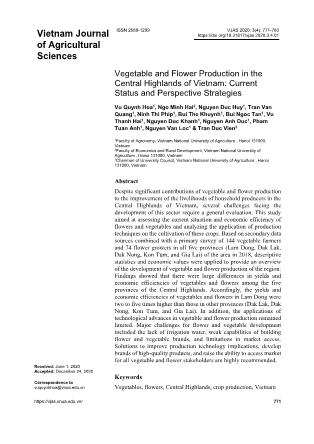
. Unstable prices and oversupply or limited access to markets remained major barriers for producers on the way to expand their farm size. Meanwhile, the solutions for vegetable and flower market and brand development by local authorities have not been paid much attention nor adopted effectively. Discussion This study is one of the first to comprehensively assess the current situation of vegetable and flower production in terms of production land, yields, quantity, economic efficiencies, negative impacts of pests/diseases on such plants, and applications of technological advances at all five provinces of the Central Highlands of Vietnam. The findings provided significant policy recommendations and practical implications for both local governments and stakeholders in these sectors. Some prior studies either focused on land use, water use (i.e., in coffee), or drought crisis in the Central Highlands (Minh, 2017; CCAFS- SEA, 2016), while others only provided information on vegetables and/or flowers in a typical location such as Da Lat city, Lam Dong (Bui Quang Tuan, 2016; Danse et al., 2007). The lack of a general evaluation limits recommendations policies and solutions for the development of vegetables and flowers in the whole Central Highlands. Our findings indicate that there was a significant difference in the production area, yields, and economic efficiency among the five provinces of the Central Highlands. Vegetables were mainly grown in Lam Dong, Dak Lak, and Gia Lai provinces, but the farmers in Lam Dong achieved the highest yield and economic efficiency. In other words, vegetables and flowers were the most economically produced in Lam Dong province, which is similar to several reports (Bui Quang Tuan, 2016; Danse et al., 2007). Meanwhile, the majority of flower areas were in Lam Dong province, others’ accounted for very minor. This implies that vegetable and flower producers in other provinces should pay more attention to improving the yields and economic values of these crops. Other scholars introduced the overall development of vegetables in Vietnam nationwide, but only placed an emphasis on the Red River Delta (i.e., Hanoi city) (Huong et al., 2013, Ngo et al., 2019). Besides that, these existing works did not evaluate the negative impacts of insects and diseases on the growth of vegetables and flowers (Bui Quang Tuan, 2016; Huong et al., 2013; Ngo et al., 2019). In this study, we identified the popularity and harmful seriousness of insects and diseases on vegetable and flower production across five provinces in the Central Highlands. Therefore, both producers and technical training provided by local government agencies are suggested to efficiently monitor and evaluate these negative effects on such crops caused by these insects and diseases. Moreover, little is known about growing techniques and technological advances that the farmers and producers applied in vegetable and flower production in this region. Our results revealed that these crop producers remained limited in applying modern water irrigation, flowering treatments, crop breeding, and post- harvest preservation technology, except for a few big producers in Lam Dong. This may explain why many producers attained low yields and economic values. Vu Quynh Hoa et al. (2020) https://vjas.vnua.edu.vn/ 781 In addition to assessing the production and economic efficiency of flower and vegetable production in the Central Highlands, this work has found the most difficulties facing the producers and farmers, which has not been pointed out by previous work. Specifically, output market issues (i.e., fluctuations in market prices and instability in output markets) were the most barriers and most concerns to the farmers in the areas. This is consistent with what has been found in previous study of Ngo et al. (2019) which was conducted in Hanoi city in the North of Vietnam. Thus, essential solutions for improving the ability to access new domestic and export markets that need to be concentrated on include building brands of high-value vegetables and flowers or improving product quality through modern technological advances. These solutions were also recommended by prior work/reports (Decision No. 936 of the Prime Minister, 2012; JICA, 2017). Apart from market factors, the negative impact of climate change (i.e., drought) was also a big challenge for plant growers, which is in accordance with other findings reported by Bui Quang Tuan (2016) and Thai (2018). The upgradation of the irrigation system for such crops is needed as 70% of cultivation areas experienced severe drought (CCAFS-SEA, 2016). This study found that vegetable and flower production played important roles in improving the likelihood of the Central Highlands’ people, especially in Lam Dong province as suggested by previous scholars (Bui Quang Tuan, 2016; Danse et al., 2007). However, many challenges hinder the development of this area such as the negative impacts of climate change, deforestation, and natural depletion, which is similar to a recent report by Thai (2018). To solve this problem, it requires a comprehensive evaluation of the current situation of agricultural production in relation to climate change that is rapidly increasing in the region. Based on the above findings, we propose policy recommendations to promote the development of the flower and vegetable industry in the Central Highlands region as follows: First, producers need to improve the yields of vegetables in the areas (i.e., Dak Lak and Dak Nong) where current yields remain much lower compared to those in Lam Dong province. The yield improvement can be done through technical training activities and the application of new seed varieties and modern technologies. Second, the supply of irrigation water for vegetable production is very important, which requires the participation and support of the local government as well as cooperations and benefit-sharing among vegetable/flower producers and businesses. Third, the local governments should support private stakeholders in building and developing brands of high-value flowers and vegetables. Fourth, it is crucial to expand markets for high-value flower and vegetable products through trade promotion activities and providing market information more widely to producers and businesses. Fifth, support policies for credit, innovating breeding technologies, and post-harvest preservation should be implemented more efficiently. These policies require close cooperation among all stakeholders (local government, producers, businesses, and research institutions) in the vegetable and flower supply chains in the Central Highlands. Nevertheless, this study still has some main limitations. First, deep analyses of the main types of flowers and vegetables in each province have not been addressed, which limits to propose specific solutions for major crops in the Central Highlands. Second, surveys of other stakeholders in the supply chain of flowers and vegetables such as processors, retailers, and consumers are missing. Finally, factors affecting economic efficiency and the application of production technology based on quantitative methods or econometric models remain absent. Thus, further research should be focused on exploring factors affecting the development of main flower and vegetable varieties in terms of economic and technical aspects through surveying all the supply chain actors. Conclusions Overall, the development of vegetables and flowers in the Central Highlands’ provinces has brought many economic benefits to producers, Vegetable and flower production in the Central Highlands of Vietnam: Current status and perspective strategies 782 Vietnam Journal of Agricultural Sciences especially in Lam Dong province. However, the growers in this area have also been facing many difficulties and challenges in both production and consumption. Production technology and technological advances for vegetable production remain limited in terms of water and fertilizer application systems, seed breeding techniques, and post-harvest preservation. Despite that, the biggest problems perceived by producers are the output market and price instability. In addition, the negative impact of climate change (i.e., drought), soil degradation, and the shortage of water sources for plant cultivation are also big obstacles for vegetable and flower production in the region. Acknowledgments This study was financially supported by the Vietnamese government for the National project Applied Research for Technology Development (Reference Number: 02/KHCN- DTDL.CN- 18/18). The authors would like to acknowledge the help of the local leaders, officials, businesses, and farmers in the five surveyed provinces (including Dak Lak, Dak Nong, Gia Lai, Kon Tum, and Lam Dong) in the Central Highlands of Vietnam. References CCAFS-SEA (2016). The drought crisis in the Central Highlands of Vietnam. Assessment Report. Retrieved from https://core.ac.uk/download/pdf/132684728.pdf on May 25, 2020. Dak Lak Statistics Office (2018). Dak Lak Statistical Yearbook 2017. Statistical Publishing House, Hanoi (in Vietnamese). Dak Nong Statistics Office (2018). Dak Nong Statistical Yearbook 2017. Statistical Publishing House, Hanoi (in Vietnamese). Danse M. G., Victoria N. G., Peeters F., Huong T. M. & Luyen, C. H. (2007). Report on Fieldwork for 'Sustainable Flowers in Vietnam', Part Two, Dalat. Retrieved from https://library.wur.nl/WebQuery/wurpubs/fulltext/185 98 on May 25, 2020. Department of Agriculture and Rural Development of Lam Dong province (2017). Report on the situation of production, consumption and development orientation of fruits and vegetables in Lam Dong province (in Vietnamese). Do H. T. T., Grant J. C., Trinh B. N., Zimmer H. C. & Nichols J. D. (2017). Diversity depends on scale in the forests of the Central Highlands of Vietnam. Journal of Asia-Pacific Biodiversity. 10(4): 472-488. FAOSTAT (2019) Database about Vietnam agriculture. Retrieved from www.fao.org/faostat/en/#country/237 on December 20, 2020. Gia Lai Statistics Office (2018). Gia Lai Statistical Yearbook 2017. Statistical Publishing House, Hanoi (in Vietnamese). Ha Anh (2016). Developing flower industry and ornamental plants in economic integration. Retrieved from https://dangcongsan.vn/kinh-te-va-hoi- nhap/phat-trien-nganh-cong-nghiep-hoa-cay-canh- trong-kinh-te-hoi-nhap-371659.html on December 20, 2020 (in Vietnamese). Huong P. T. T., Everaarts A. P., Neeteson J. J. & Struik P. C. (2013). Vegetable production in the Red River Delta of Vietnam. I. Opportunities and constraints. NJAS – Wageningen Journal of Life Sciences. 67: 27-36. Quang Huy (2017). Central Highlands Steering Committee: Annual average economic growth of over 10%. Retrieved from https://bnews.vn/ban-chi-dao-tay- nguyen-tang-truong-kinh-te-binh-quan-hang-nam-dat- tren-10-/51127.html on June 1, 2020 (in Vietnamese). JICA (2017). Data collection survey for formulating branding and promotion strategy of agricultural products and agro-tourism in Lam Dong province. Final Report. Retrieved from https://openjicareport.jica.go.jp/pdf/12286944.pdf on June 1, 2020. Kon Tum Statistics Office (2018). Kon Tum Statistical Yearbook 2017. Statistical Publishing House, Hanoi (in Vietnamese). Nguyen Khoi (2015). The Central Highlands Program 3 - interdisciplinary integrated science and technology program. Retrieved from www.nhandan.com.vn/khoahoc- congnghe/item/28314702-tay-nguyen-3-–-chuong- trinh-khoa-hoc-va-cong-nghe-tong-hop-lien- nganh.html on December 10, 2019 (in Vietnamese). Lam Dong Statistics Office (2018). Lam Dong Statistical Yearbook 2017. Statistical Publishing House, Hanoi (in Vietnamese). Lamdongdost (2016). How Da Lat flower brand becomes strong? Retrieved from trung/Hoa-da-lat/type/detail/id/1008 on December 20, 2020 (in Vietnamese). Lamdongtv (2016). Export proportion of cut flowers in Da Lat remains low. Retrieved from san-xuat-lua-chat-luong-cao-dat-hon-7500-ha.html on September 10, 2020 (in Vietnamese). Nguyen Cong Ly (2017). The socio-economic status of the Central Highlands has developed rapidly and comprehensively. Retrieved from Vu Quynh Hoa et al. (2020) https://vjas.vnua.edu.vn/ 783 www.nhandan.com.vn/chinhtri/item/31794502-kinh- te-xa-hoi-vung-tay-nguyen-phat-trien-nhanh-va-toan- dien.html on December 12, 2019 (in Vietnamese). MARD (2009). Manual of agricultural land use, volume 2. Science and Technique Publishing House, Hanoi (in Vietnamese). MPI (2017). Synthetical report of the adjustment of the Master Plan for socio-economic development in the Central Highlands region to adapt to climate change. Retrieved from 1034-4a2e-9119-86ff48b69edd/BCTH-QH-Tay- Nguyen-3-5-2017-(in-xin-y-kien-Bo,-nganh).pdf.aspx on December 15, 2019 (in Vietnamese). Ngo H. M., Vu H. Q., Liu R., Moritaka M. & Fukuda S. (2019). Challenges for the Development of Safe Vegetables in Vietnam: An Insight into the Supply Chains in Hanoi city. Journal of Faculty of Agriculture, Kyushu University. 64(2): 355-365. People Committe of Dak Lak province (2018). Report on the results of socio-economic development plan in 2017 and implementing plan for 2018. Plant Protection Bureau of Lam Dong (2016). Assessing the current situation of developing safe vegetable production from 2005 to 2015 and directions and solutions for developing safe vegetables in Lam Dong province in the 2016-2020 period (in Vietnamese). Decision No. 936 of the Prime Minister (2012). Approving of the Master Plan on Socio-Economic Development of the Central Highlands up to 2020 (in Vietnamese). Bui Quang Tuan (2016). Economic restruturing of the Central Highlands toward sustainable development. Social Sciences Publishing House, Hanoi (in Vietnamese). Thai H. A. C. (2018). Livelihood Pathways of Indigenous People in Vietnam’s Central Highlands: Exploring Land-Use Change. Advances in Asian Human- Environmental Research. Springer International Publishing. Van Hoi P., Mol A. P. & Oosterveer P. J. (2009). Market governance for safe food in developing countries: The case of low-pesticide vegetables in Vietnam. Journal of Environmental Management. 91(2): 380-388. World Bank (2017). Vietnam Food Safety Risk Management – Challenges and Opportunities. Publishing and Knowledge Division. The World Bank, 1818 H Street NW, Washington, DC 20433, USA: 28-34.
File đính kèm:
 vegetable_and_flower_production_in_the_central_highlands_of.pdf
vegetable_and_flower_production_in_the_central_highlands_of.pdf

